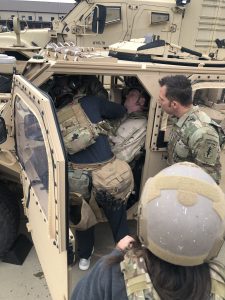

The highlight of Week 3 was our visit to Fort Bragg, where we experienced on-the-ground scenarios with casualties, had time to speak with numerous military personnel, and even got to ‘test’ the quality of MREs (Meals-Ready-to-Eat).
We then spent Week 4 synthesizing our new insights from Fort Bragg and continued our beneficiary interviews, where we learned more about the workflow of medical personnel during deployment as well as in-depth communication logistics. A highlight of our week was also meeting with former Chairman of the Joint Chiefs, General(R) Martin Dempsey. His insight was invaluable to the big picture of our problem and is summarized, along with our other interviews, below.
Looking ahead, we will start to build our initial product based on the architecture outlined in our Week 4 presentation, which will allow us to test greater hypotheses with even more upcoming interviews.
Stay tuned, and God Bless.
– Duke Team 3
Matt Runyan: Network Consulting Engineer, Cisco Systems
– Whatsapp constantly tries to make connections
– Other apps can have interrupted messages because of unstable connections
Josh Clark: 18E
– Commercial networking shares data faster but is less consistent; army is more consistent but has slower data sharing
– Heavier encryption worsens signal
– Would be ideal to have photos in app stored locally that can then be recalled separately from photos taken in other situations
Mike Thomas: Military Business Development Manager, GoTenna
– GoTenna is built based on line-of-sight, which makes it possible to relay information via drone (up to 52 miles)
– To get more range, need device offered by GoTenna for short distance mesh networking
– Funding of devices from the military operates on Life Cycle Analysis of 10, 20, or 30 year costs
Mike Fiocca: Former 18D
– Resources e.g. ebooks for non-trauma procedures to save time and resources
– Voices assistance that can operate without internet connection would be helpful
– Protocols and algorithms for all trauma procedures
Pat Butler: Former 18E
– Interconnected devices that would allow for smoother transmission of data
– Redundancies can be helpful to prevent loss of information, but lightening the load would be ideal
– MyVPN is helpful to tunnel through local internet
JA: Former 18D, current anesthesia resident, Duke University Medical Center
– Ultrasound is really useful for diagnosing volume loss
– One of the biggest problems is lack of basic knowledge understanding that then impairs communication between 18D and the support physician
– Notability or similar app has been helpful in the past
Martin Dempsey: 18th Chairman of the Joint Chiefs of Staff
– Product has to not only function with on-the-ground personnel, but also with higher ups
– How to potentially quantify success?
Kevin Iskra: Former 18D
– Doctrine of treatment: Medics treat on the ground, then evacuate to physician’s assistant
– Most time intensive tasks: pulse and blood pressure
– Documentation card or critical care card would be really helpful to transfer data to the next level
Zach Pearson: Team Sergeant
– Need to take vitals at regular intervals. Currently vitals are transferred by taking a photo
– SOFACC can be a beneficiary: closest thing to medic that’s not a medic
– Focus on TCCC: Tactical Combat Casualty Care
Phil K Bohan: General Surgery Resident, San Antonio Medical Center
– Organization of trauma care as they move from the field to hospitals in the U.S.
– Ideal would be more live way of transmitting vitals. Physicians use vitals to decide whether to continue to treat or not
– Blood transfusion, esp live blood banks, can knock the person out for several days from combat
James Horne: former 18A, SOFACC grad, current Fuqua student
– Communications should include the most reliable ones and other fancy modes of communication
– Operational Detachment groups usually consist of 3 people; Operational Detachment Alpha consist of 12 people
– Usually there’s only one chance per day to sync your record or get remote assistance
– Medics have autonomy to adopt telemedicine or not
PL: Prolonged Field Care Working Group
– 2 Types of challenging environments: austere env e.g. Africa, or mega cities like in China
– For vital records, prompts would be helpful, and voice dictation would be useful, but might be problematic in noisy environment esp in mega cities
– “Anything we do has to be layers to the overall solution.”
TO: Former 18E
– Mainly use iridium to connect satellite phones, often to connect with physicians
– PACE plan: mission dependent, necessity for high-threat operational environment, non-necessity for low threat via truck radio or satellite
– Data compressors used include NX powerlite (COTS)
Personnel Interviewed during visit to Fort Bragg:
Aaron Jefferson, Signals Officer
Chandler Merrell, 18D
Dr. Paul Tate, Battalion Surgeon
SFC Michael Goggin, 18D instructer, former 18D
MSG Kevin Schwartz, SOFACC Instructor
LTC David Lewis, SOFACC Instructor
Adam Russell, Instructor, Remote Medical Institute
LT Carl Ellison, 18E
SGT Tim Lanning, SIGDET Operations NCO
Alexi Kotchetov, 18E
